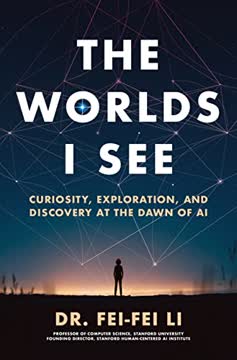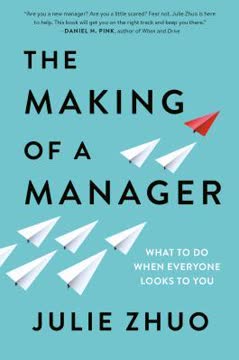Key Takeaways
1. Embrace Change: Give Yourself Permission to Imagine and Act
Permission granted! Ignore the Gatekeepers.
Self-permission is crucial. To effect change, one must first grant themselves permission to challenge the status quo and pursue new ideas. This often means ignoring gatekeepers – those who resist change and protect existing power structures. Comstock's journey from PR professional to GE's chief marketing officer illustrates the power of self-permission in driving personal and organizational transformation.
Overcome fear and take action. Change-makers must develop the courage to act despite uncertainty and potential failure. This involves:
- Recognizing and confronting your fears
- Developing a bias for action
- Learning from failures and persevering
- Building social courage to connect with others and share ideas
Challenge assumptions and think differently. To drive innovation, question established norms and explore alternative perspectives. This may involve:
- Seeking out diverse viewpoints
- Embracing "outsider" thinking
- Encouraging creative problem-solving
- Fostering a culture that values curiosity and experimentation
2. Discover and Shape the Future Through Pattern Recognition
We can no longer afford to fail to imagine.
Cultivate pattern recognition skills. The ability to identify emerging trends and weak signals is crucial for anticipating and shaping the future. This involves:
- Developing a broad awareness of your environment
- Resisting the urge to fixate on any one thing
- Connecting seemingly unrelated dots
- Trusting your intuition and acting on hunches
Engage in discovery-driven planning. Rather than relying solely on traditional strategic planning, adopt a more flexible approach that embraces uncertainty:
- Start with a hypothesis and test assumptions
- Gather data through experimentation and customer feedback
- Iterate and refine your approach based on new insights
- Be willing to pivot or abandon ideas that aren't working
Create a discovery mindset within your organization. Foster a culture that values exploration and learning:
- Encourage employees to seek out new experiences and perspectives
- Allocate time and resources for discovery activities
- Reward curiosity and initiative
- Share insights and learnings across the organization
3. Harness Tension and Conflict as Engines of Innovation
Tension is the price of admission when you are innovating.
Embrace constructive conflict. Innovation often arises from the tension between different ideas, perspectives, and approaches. Instead of avoiding conflict, learn to harness it:
- Encourage healthy debate and diverse viewpoints
- Create psychological safety for team members to express disagreement
- Focus on the ideas, not personal attacks
- Use conflict as a tool for refining and improving concepts
Develop agitated inquiry skills. Learn to ask probing questions and challenge assumptions in a constructive manner:
- Practice active listening
- Seek to understand different perspectives
- Ask "why" and "what if" questions
- Encourage others to question your ideas as well
Balance tension with collaboration. While conflict can drive innovation, it's essential to maintain a collaborative environment:
- Establish shared goals and values
- Foster trust and mutual respect among team members
- Celebrate diverse contributions to the innovation process
- Develop skills in conflict resolution and negotiation
4. Craft Compelling Narratives to Drive Organizational Change
Strategy is a story well told.
Develop a clear and inspiring vision. Craft a narrative that articulates where your organization is going and why it matters:
- Connect your vision to broader societal trends and needs
- Make it emotionally resonant and aspirational
- Ensure it's grounded in your organization's core strengths and values
- Communicate it consistently and passionately
Use storytelling to drive change. Narratives are powerful tools for influencing behavior and shifting mindsets:
- Share stories of success and learning from failure
- Use metaphors and analogies to make complex ideas more accessible
- Highlight the human impact of your organization's work
- Encourage employees to become storytellers and ambassadors for change
Align actions with narratives. Ensure that your organization's behavior matches its stated vision and values:
- Make strategic decisions that reinforce your narrative
- Celebrate actions and outcomes that exemplify your story
- Address inconsistencies honestly and transparently
- Continuously refine and evolve your narrative based on feedback and results
5. Become a Digital Industrial Company: The Industrial Internet
Software is eating the world, but the physical world isn't going away anytime soon.
Embrace the convergence of physical and digital. Recognize that the future of industry lies in the integration of traditional industrial capabilities with digital technologies:
- Invest in sensors, data analytics, and connectivity for physical assets
- Develop software platforms to optimize industrial operations
- Create new business models based on data-driven insights
- Build partnerships between industrial and technology companies
Focus on customer outcomes. Shift from selling products to delivering solutions that address customers' most pressing needs:
- Use data to understand customer pain points and opportunities
- Develop outcome-based pricing and service models
- Create digital ecosystems that add value throughout the customer journey
- Continuously innovate based on real-time customer feedback
Build digital capabilities and culture. Transform your organization to thrive in the digital industrial era:
- Recruit and develop talent with both industrial and digital expertise
- Foster a culture of experimentation and rapid iteration
- Invest in digital infrastructure and tools
- Encourage cross-functional collaboration and knowledge sharing
6. Foster an Adaptive Organization Through Lean Startup Methods
Fail fast, fail small, learn, and iterate.
Adopt lean startup principles. Apply the build-measure-learn cycle to accelerate innovation and reduce risk:
- Start with a minimum viable product (MVP) to test key assumptions
- Gather customer feedback early and often
- Use data to make decisions about pivoting or persevering
- Embrace rapid iteration and continuous improvement
Implement growth boards. Create a structured process for evaluating and funding innovation projects:
- Establish clear criteria for advancing projects through stages
- Allocate resources based on validated learning and progress
- Kill projects early that aren't meeting milestones
- Encourage calculated risk-taking and learning from failure
Develop emergent leadership skills. Cultivate leaders who can navigate uncertainty and drive innovation:
- Balance passion with humility
- Embrace ambiguity and complexity
- Foster a growth mindset within teams
- Develop skills in facilitation and coaching
7. Build a Culture of Continuous Learning and Innovation
Everything is feedback. It's all data to plug into the process.
Create psychological safety. Foster an environment where employees feel safe to take risks, share ideas, and learn from failure:
- Encourage open communication and transparency
- Celebrate learning and growth, not just success
- Address failures as opportunities for improvement
- Model vulnerability and openness to feedback as a leader
Invest in diverse perspectives. Actively seek out and integrate diverse viewpoints to drive innovation:
- Build diverse teams across functions, backgrounds, and expertise
- Engage with external partners, customers, and thought leaders
- Encourage reverse mentoring and cross-generational learning
- Create forums for sharing ideas and challenging assumptions
Develop a learning infrastructure. Build systems and processes that support continuous learning and knowledge sharing:
- Implement regular retrospectives and learning reviews
- Create platforms for capturing and disseminating insights
- Allocate time and resources for experimentation and skill development
- Align performance metrics and incentives with learning and innovation goals
Cultivate a growth mindset. Encourage employees at all levels to embrace challenges and see failures as opportunities for growth:
- Provide training on growth mindset principles
- Recognize and reward effort and progress, not just outcomes
- Encourage employees to set stretch goals and take on new challenges
- Share stories of personal and professional growth throughout the organization
</instructions>
Last updated:
Review Summary
Imagine It Forward received mixed reviews, with an average rating of 3.80 out of 5. Many readers praised Comstock's candid storytelling and insights on innovation and change management in large corporations. Some found the book inspirational and practical for aspiring change-makers. However, critics felt it was too long, overly focused on memoir content, and lacking in concrete business advice. The book's exploration of GE's culture and Comstock's career journey resonated with some readers but fell flat for others expecting more actionable strategies.
Similar Books










Download PDF
Download EPUB
.epub digital book format is ideal for reading ebooks on phones, tablets, and e-readers.




